Molding and Casting
So the objective of this week is to get introduced to the Molding and Casting procedure used mainly to produce a certain shape multiple times using various material.
Molding and Casting is usually used in the Plastics industry and automotive industry, where the same object is mass produced. In the plastic manufacturing industry, injection molding is usually used to produce the plastic products. The procedure is also used when we want to produce shapes using other material such as wax, foam, rubber, silicone and resin. Molding and Casting is also used to produce sand casted metalic parts such as aluminum, steel, lead and much more.
In this section, we will learn on how to prepare a Mold and use it to Cast a certain object.
Group Assinment
The group assginment was to review the safety data sheets for each of your molding and casting materials, then make and compare test casts with each of them.
Molding or moulding is the process of manufacturing by shaping liquid or pliable raw material using a rigid frame called a mold or matrix.This itself may have been made using a pattern or model of the final object. Casting is a manufacturing process in which a liquid material is usually poured into a mold, which contains a hollow cavity of the desired shape, and then allowed to solidify. The solidified part is also known as a casting, which is ejected or broken out of the mold to complete the process.
Machines Used
The main machine used in this week's assignment is the Desktop CNC Machine.
- The Roland MDX-40 was used for cnc milling the wax block that what then used for pouring silicone in it.
Testing Molding and Casting Material
The machine used: Roland MDX-40
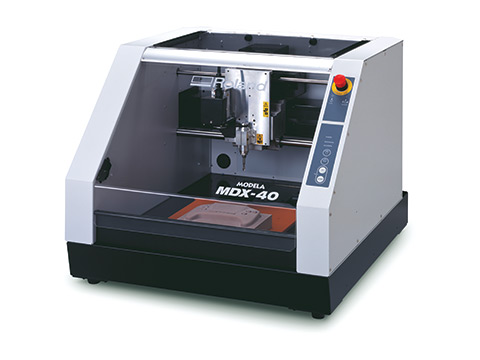
The assignment this week was to review the safety data sheets for each of your molding and casting materials, then make and compare test casts with each of them.
The following are the material we used in this week's assignment.
- Molding Material
- Casting Material
Test 1 - Testing Various Molding Material
In order to perform this week's assignment, we tried two differnt Molding Material and we compared the technical specification and the results.
The following material were available in the lab and were used during this week's assignment:
- Molding Material 1 - Alumilite - Amazing Mold Rubber
- Molding Material 2 - Alumilite - High Strength 2
Concerning Safety, both material had the same safety warnings:
Always use safety products when working with silicone and resin. Always wear gloves, apron, coveralls, boots, chemical goggles.
Mixed High Strength rubber will absorb into porous materials and may stain! Avoid clothing, carpet, upholstery, and any other porous materials which will stain and will not come out. Mold making and casting is best done in a designated area such as a basement, garage, or hobby room with adequate air movement or ventilation. Cover any surfaces including floors with plastic sheeting, or plywood to prevent damage from spilled resin. To clean up unmixed or still liquid material, use rubbing alcohol on a rag or paper towel to quickly clean and remove. In some instances, such as spills on non-porous surfaces, it's easier to clean up silicone after it's allowed to cure. Then simply peel away and discard.
The following are the safety warning for both material:
- Keep out of reach of children
- Avoid eye and skin contact.
- In case of skin contact, wash with soap and water
- Use with ventilation. In case of ill effects, remove to fresh air
- Keep container closed
- Do not take internally.
- Do not use for food.
A detailed discription of the technical data sheet for both materials is described below.
You can download the data sheet for the material from the following links
Amazing Mold Rubber
High Strength 2
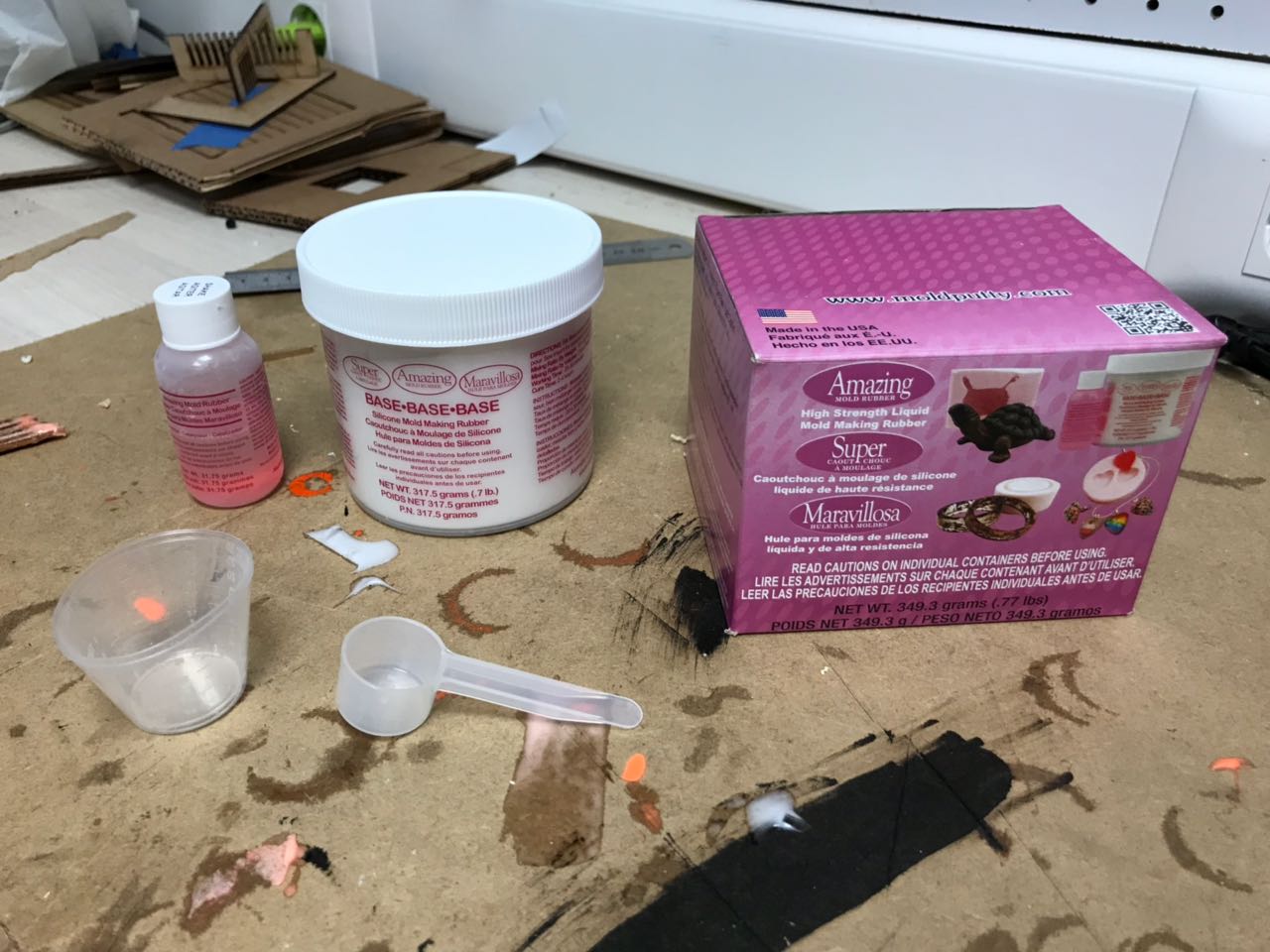
Material 1 - Amazing Mold Rubber
The following is a summary of the data sheet of the Amazing Mold Rubber.
- Color: Pink
- Mix Ratio: 10:1 by WEIGHT
- Open Time: 20-30 mins
- Demold Time: 2-4 hours
- Mixed Viscosity (cps.): 15,000
- Specific Gravity: 1.15
- Shore A Hardness 25
- Linear Shrink (%) .3
- Tensile Strength (psi) 550
- Elongation 500%
- Temperature Range (F) -67 to 395
- Vacuum Required No
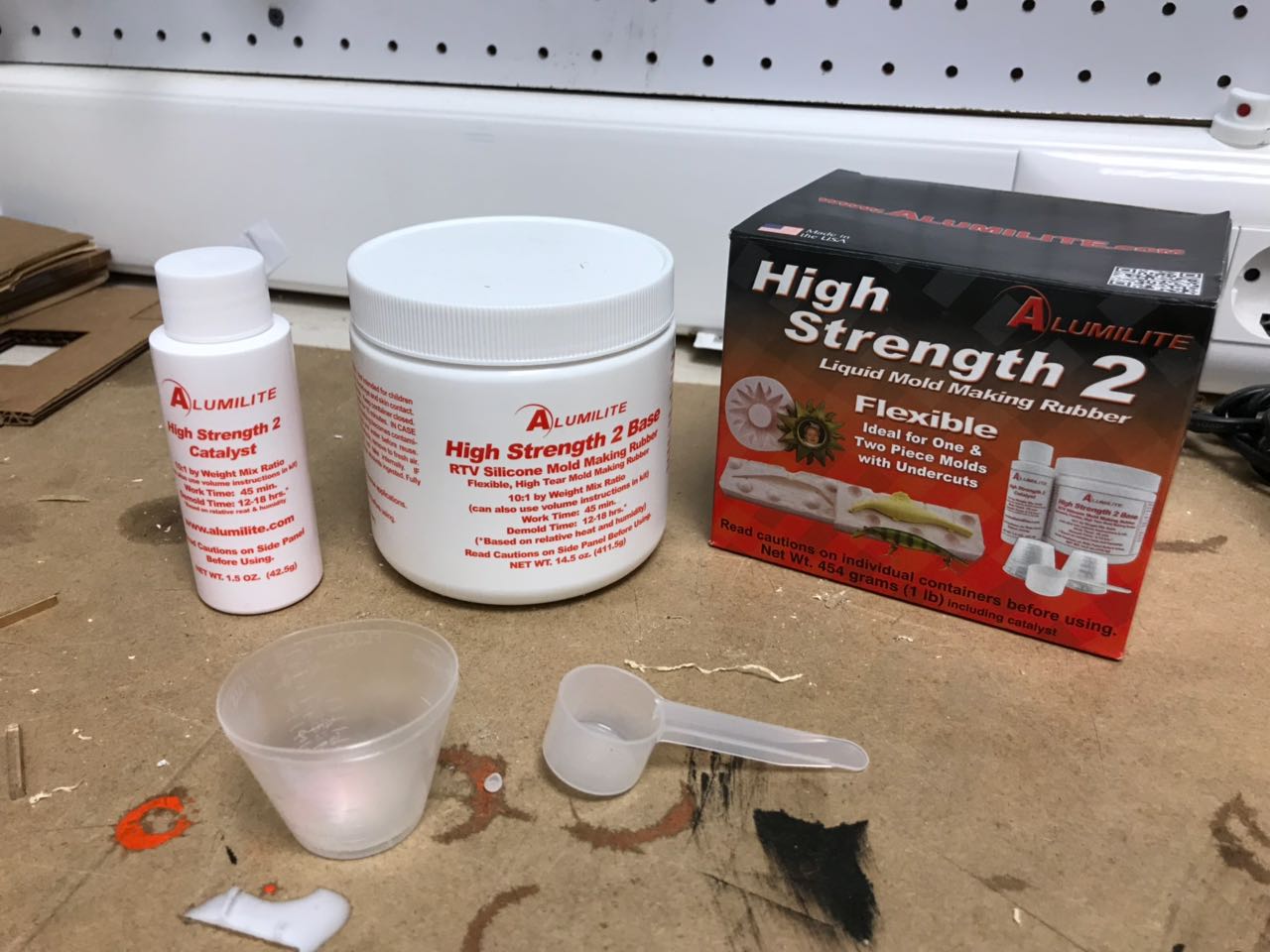
Material 2 - High Strength 2
The following is a summary of the data sheet of the High Strength 2.
- Color: Pink
- Mix Ratio: 10:1 by WEIGHT
- Open Time: 45 mins
- Demold Time: 12-18 hours
- Mixed Viscosity (cps.): 18,000
- Specific Gravity: 1.15
- Shore A Hardness 25
- Linear Shrink (%) .3
- Tensile Strength (psi) 550
- Elongation 500%
- Temperature Range (F) -67 to 395
- Vacuum Required No
We can notice that this material takes more time to cure than material 1. However both have almost the same final result which is a high tear strength rubber material.
Test 2 - Testing Various Casting Material
In order to perform this week's assignment, we tried many types of casting material and we compared the technical specification and the results.
The following material were available in the lab and were used during this week's assignment:
- Casting Material 1 - Alumilite - Amazing Casting Resin - White
- Casting Material 2 - Alumilite - Amazing Clear Cast
- Casting Material 3 - Aristocrat - Liquid Glass
- Casting Material 4 - PolyPol - 1003
- Coloring Material - Alumilite Coloring Dyes, Various Colors
Concerning Safety, all material had the same safety warnings:
Always use safety products when working with resin. Always wear gloves, apron, coveralls, boots, chemical goggles.
Hardener contains a polyamine curing agent.
Polymer should be used only by adults or under close supervision by an adult. KEEP OUT OF REACH OF CHILDREN.
The following are the safety warning for all material:
- Fatal or harmful if swallowed
- Keep out of reach of children
- Avoid eye and skin contact.in case of eye contact, flush with water for ten minutes and seek prompt medical attention.
- In case of skin contact, wash with soap and water. Resin and hardener are skin irritants and may cause allergic reaction.
- AVOID INHALATION – Use in well ventilated areas.. In case of ill effects, remove to fresh air
- Keep container closed
- Do not take internally.
- Do not use for food.
A detailed discription of the technical data sheet for both materials is described below.
You can download the data sheet for the material from the following links
Casting Material 1 - Alumilite - Amazing Casting Resin - White
Casting Material 2 - Alumilite - Amazing Clear Cast
Casting Material 3 - Aristocrat - Liquid Glass
Casting Material 4 - PolyPol - 1003
Coloring Material - Alumilite Coloring Dyes, Various Colors
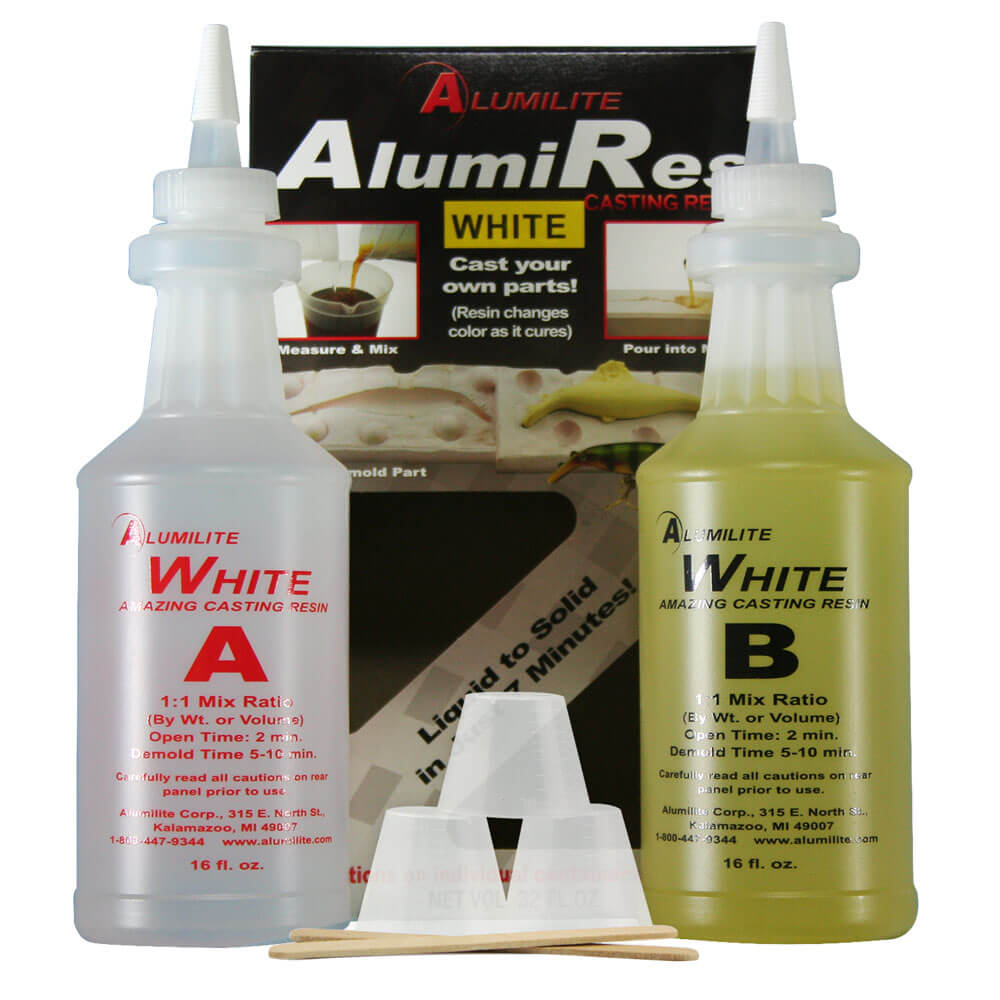
Material 1 - Alumilite - Amazing Casting Resin - White
The following is a summary of the data sheet of the Amazing Casting Resin - White.
- Color: White
- Mixed Viscosity (cps.): 90
- Hardness Shore D: 72
- Specific Gravity: 1.05
- Shrinkage (in/in): 0.006
- Tensile Strength (psi): 4500
- Elongation: 10%
- Heat Deflection (Degrees F) 185
- Izod Impact (lb/in): 0.40
- Compression (psi): 6,000
The following are General Properties for the material.
- Color "A": Clear
- Color "B": Translucent yellow
- Mix Ratio: 1:1 by WEIGHT or Volume
- Open Time: 2.5-3 mins
- Demold Time: 5-15 mins
- Full Cure Schedule: 72 Hours
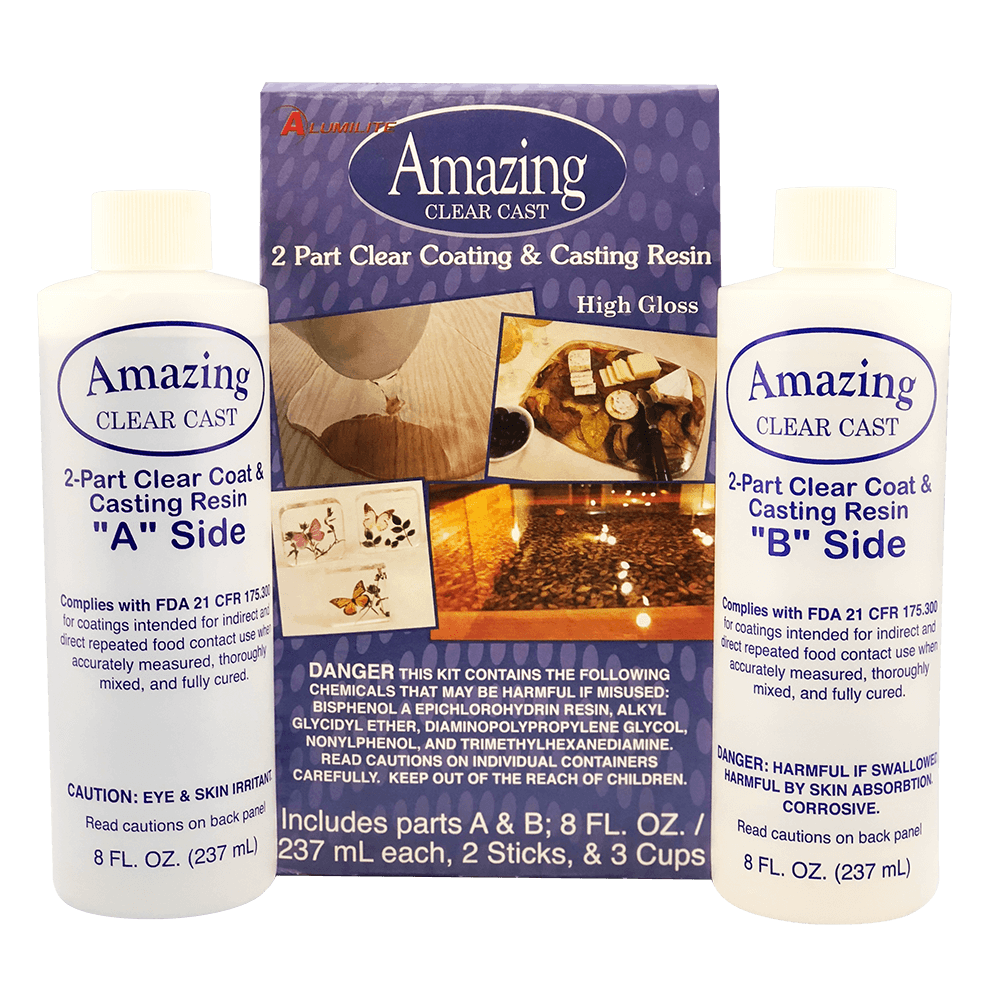
Material 2 - Alumilite - Amazing Clear Cast
The following is a summary of the data sheet of the Amazing Clear Cast.
- Color: Clear
- Mixed Viscosity (cps.): 2,600
- Hardness Shore D: 80
- Specific Gravity: 1.08
- Shrinkage (in/in): 0.003
- Tensile Strength (psi): 8,000
- Elongation: 1-3%
- Heat Deflection (Degrees F) N/A
- Izod Impact (lb/in): 2.26
- Compression (psi): 27,000
The following are General Properties for the material.
- Color "A": Translucent Blue
- Color "B": Clear
- Mix Ratio: 1:1 by WEIGHT or Volume
- Open Time: 45-60 mins
- Demold Time: 18-24 mins
- Full Cure Schedule: 72 Hours
We can notice that this material takes more time to cure than material 1. .

Material 3 - Aristocrat - Liquid Glass
The following is a summary of the data sheet of the Aristocrat - Liquid Glass.
- Color: Clear(Yellowish)
- Hardness Shore D: 81-83
- Shrinkage (in/in): 0.003
- Tensile Strength (psi): 5,800
- Elongation: 7%
- Izod Impact (lb/in): 0.95
- Compression (psi): 3,500
The following are General Properties for the material.
- Color "A": Translucent Blue
- Color "B": Clear
- Mix Ratio: 1:1 by WEIGHT or Volume
- Open Time: 10-15 mins
- Demold Time: 18-24 mins
- Full Cure Schedule: 72 Hours
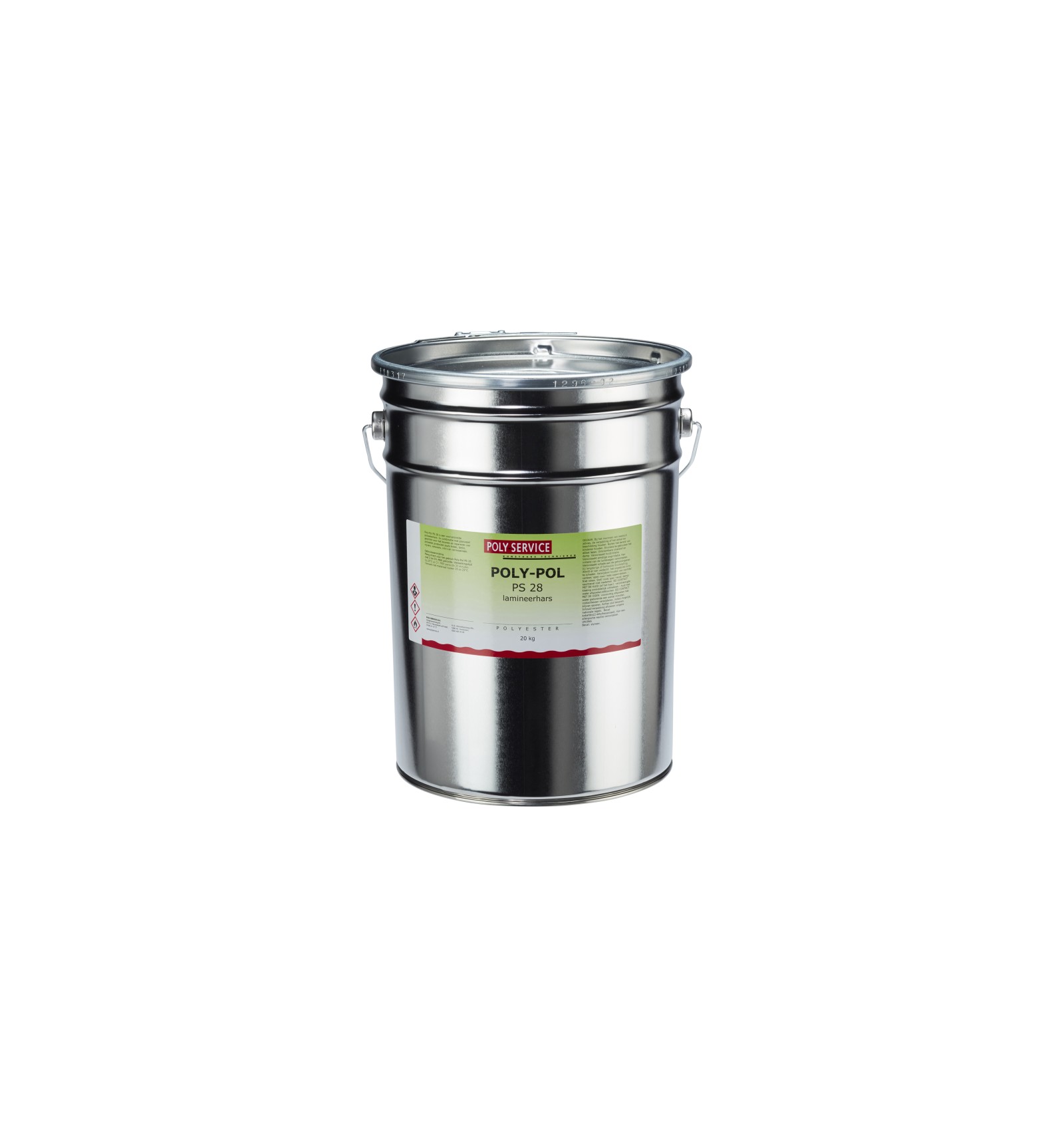
Material 4 - PolyPol - 1003
The following is a summary of the data sheet of the PolyPol - 1003.
- Color: Bluish Cloudy Viscous Liquid
- Mixed Viscosity (cps.): 600-800
- Specific Gravity: 1.1-1.2
- Tensile Strength (MPa): 60
The following are General Properties for the material.
- Color "A": Translucent Blue
- Color "B": Clear
- Mix Ratio: 3% by Volume
- Open Time: 15-25 mins
- Demold Time: 25-35 mins
- Full Cure Schedule: 72 Hours







